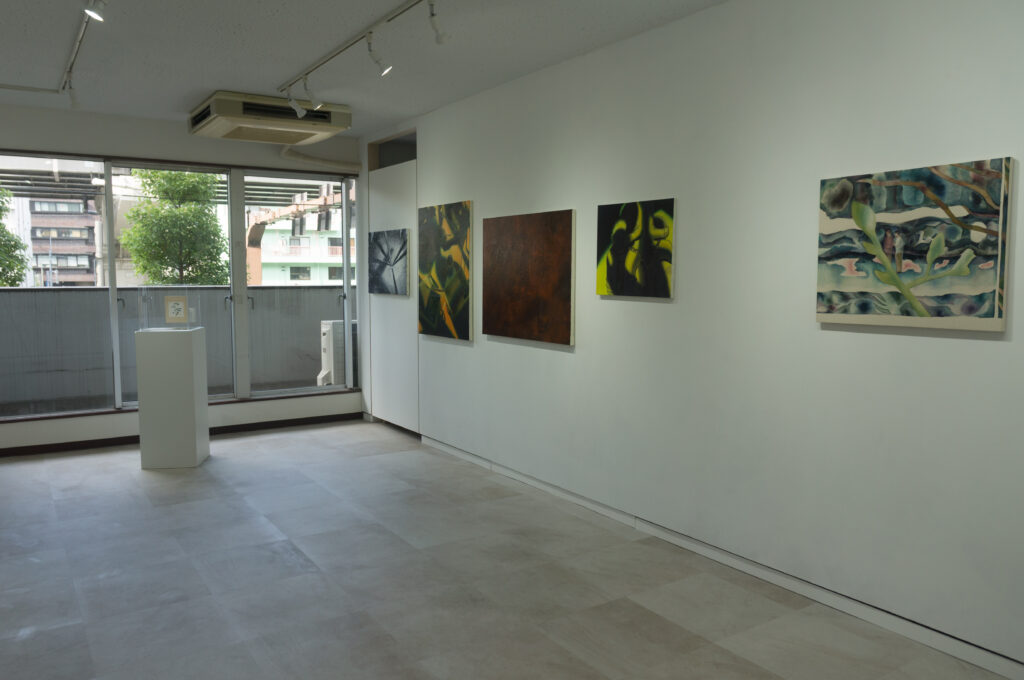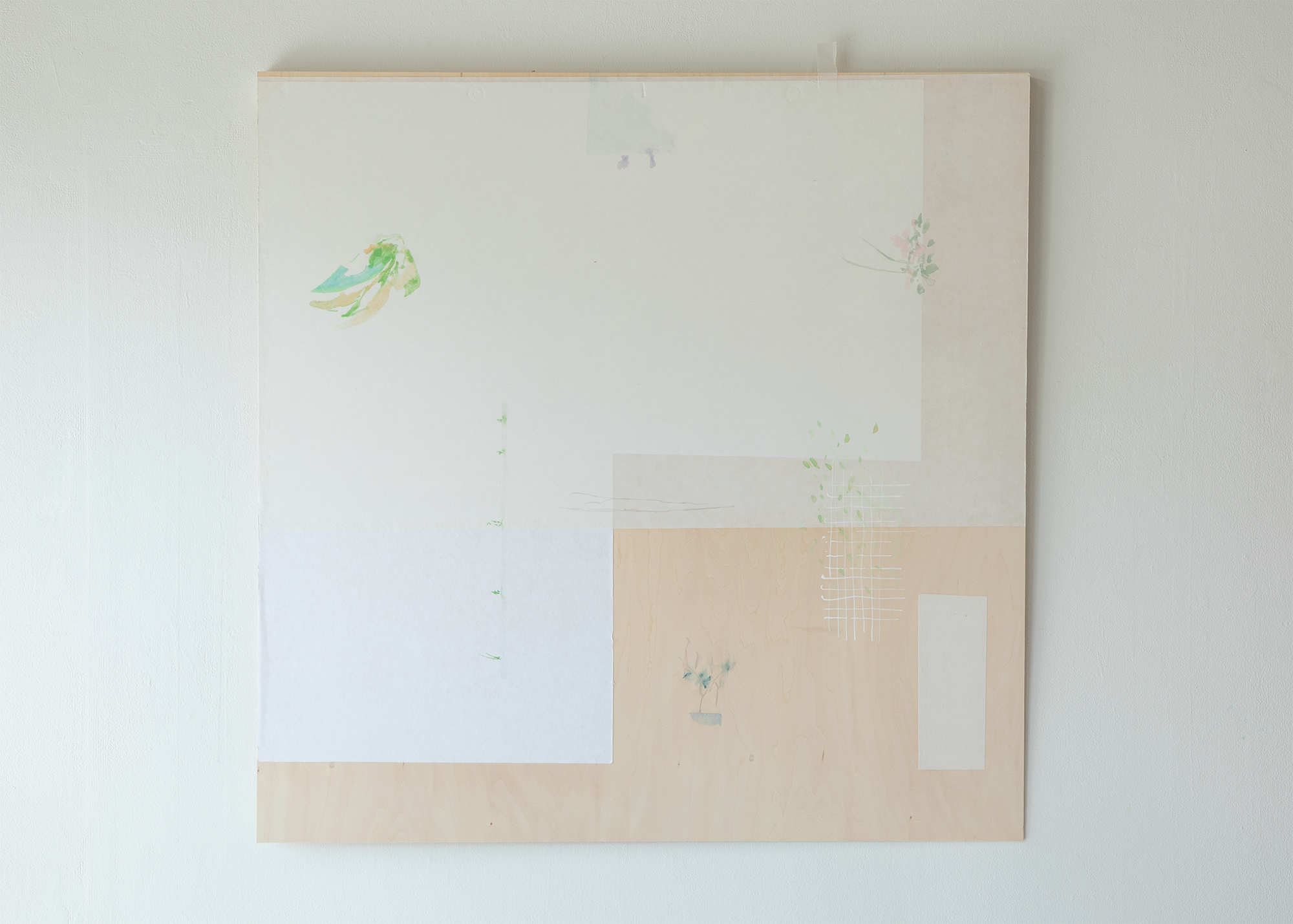aaploit is pleased to present “Chiasme,” a group exhibition featuring four artists—Ishiguro Hikaru, Ishimatsu Yufu, Tazaki Ari, and Matsuda Nayuko—running from Friday, July 4 to Sunday, July 27, 2025.
Visiting “Chiasme,” audiences will discover four artists who transform the simple act of looking into something more complex and rewarding. The exhibition space will reveal works that seem to look back at their viewers, creating moments where the boundary between observer and observed becomes beautifully unclear. aaploit has carefully positioned these four practices to create unexpected dialogues throughout the gallery space, where visitors will find that what begins as simple observation gradually becomes something more intimate and participatory.

The exhibition takes its title from “Chiasme”—a concept philosopher Maurice Merleau-Ponty used to capture something profound about how we inhabit the world. When your right hand touches your left, you are simultaneously the one who touches and the one being touched. Subject and object blur, intertwine, become inseparable. In seeing, too, a landscape doesn’t merely present itself to our eyes—its colors seep into us, stirring memories, awakening something within that wasn’t there before.*1
The exhibition offers visitors an alternative to predictable viewing experiences—encounters that invite genuine discovery and personal transformation through sustained engagement with works that respond to presence, movement, and careful attention.
Four Distinct Approaches
Ishiguro Hikaru: Layered Narratives in Paint
Ishiguro Hikaru will present paintings that shimmer with mysterious narratives, where delicate butterflies, moths, and floating faces create an atmosphere of beautiful uncertainty.
Butterflies, moths, shells: these creatures and objects drift through her canvases, each one poised on the edge of transformation. Life and death, fragility and persistence, the material and the spectral—they refuse to stay in their separate categories. The faces that emerge, suspended in her painted atmospheres, are what she calls her “precious children.” Neither fully girl nor woman, neither wholly present nor absent, they inhabit that uncertain space where consciousness flickers between waking and dreaming.
When you encounter these works, something strange happens with seeing itself. Whose eyes are meeting whose? The painted gaze reaches back, makes you suddenly aware of your own looking, draws you into a conversation you didn’t know you were having.
This is Ishiguro’s way of working through loss—what Freud called the “work of mourning”—but transformed into something beyond the personal. In her dialogue with the figure, with the very idea of “person,” she’s asking bigger questions about what it means to be a self in a world that constantly threatens to dissolve those boundaries.
Ishimatsu Yufu: Memory in Motion
Ishimatsu Yufu’s installation “A Vessel Filling a Cup, Breathing Within” (2025) will transform the gallery’s staircase landing, responding to visitors’ movement as they navigate the space.
“A Vessel Filling a Cup, Breathing Within” (2025) lives on a staircase landing, responding to your body as you climb. Each step shifts the work slightly; the rhythm of your movement becomes part of its meaning. The wooden supports that would normally hide behind the painting are made transparent, so they float alongside the grasses and flowers painted on Japanese paper—structure and image dissolving into each other, neither more real than the other.
The rock pigments she uses carry their own memory—mineral fragments that speak to the granular, shifting nature of how we actually remember. The boards warp intentionally over time, becoming a physical record of change, of the instability that memory insists on despite our wishes to fix it in place.
Fusuma, screens, hanging scrolls—Japanese painting has always lived inside daily life, not separate from it. As our ways of living change, Ishimatsu quietly asks: what would it mean for painting to come home again? Using the ancient vocabulary of Japanese painting, she pushes into new territory—making the invisible visible, bringing painting off the wall and into the spaces we move through. Through this work, the boundary between art and life becomes not something to cross, but something to inhabit.
Tazaki Ari: When Observer Becomes Observed
Tazaki Ari will present “Endless Circle,” a work that immediately places visitors in an unusual position through its goggle-shaped frame that covers the entire canvas.
“Endless Circle” puts you in an unusual position from the moment you approach it. The goggle-shaped frame that covers the entire canvas doesn’t just show you a scene—it makes you feel like you’re looking through diving goggles, pulled into an underwater world. But here’s the twist: while you’re looking at an eagle hunting beneath the surface, there’s also a circle of people, like children playing “kagome kagome,” that ancient game where someone sits blindfolded in the center while others move around them in a ring.
This isn’t just a painting you stand in front of. The human circle spills out beyond the canvas edges, and that goggle frame? It’s designed to include you, to make you part of what’s happening. Suddenly you’re not safely outside looking in—you’re caught up in the same web of relationships, the same “chain of influence” that connects all living things.
Tazaki doesn’t judge this entanglement. Tazaki simply shows us that we’re already in it, whether we realize it or not. In our modern world, we like to think we can observe nature from a distance, study it, control it. But Tazaki’s paintings remind us: we’re part of the system we’re trying to observe. We affect what we watch, and what we watch affects us right back.
Through this work, looking itself becomes something different—not a one-way street, but a conversation where both sides are constantly changing.
Matsuda Nayuko: Where Colors Breathe
Matsuda Nayuko’s “Yuri-shiro-iro no” will greet visitors with subtle color relationships that seem to shift and breathe as they spend time with the work.
“Yuri-shiro-iro no” starts with blues and greens, but as you spend time with it, hints of pink and purple begin to surface, like memories rising to consciousness. Matsuda leaves deliberate gaps—spaces where the paint doesn’t go, where your own thoughts can enter. These aren’t empty spaces; they’re breathing room for both the painting and for you.
Watch how the colors bleed into each other through her technique. It’s not controlled in the way we usually think of painting. Instead, it’s more like watching how feelings change over time—gradual, unpredictable, but somehow inevitable. The forms that emerge feel organic, alive, as if they grew rather than were painted.
These aren’t paintings that tell you what to see. They’re more like starting points for your own inner conversations. Each person brings their own memories, their own emotional landscape, and the work responds differently. The title itself—”Yuri-shiro-iro no”—plays with the multiple meanings words can hold, just as the visual forms shift between being landscape, memory, feeling, dream.
Standing in front of Matsuda’s work, you realize you’re not just looking at something. You’re participating in it. The painting is watching you back, responding to what you bring to it, creating new meanings in the space between you.
Convergent Meanings
Together, these four artists will transform aaploit’s gallery space into an environment where the traditional boundaries between viewer and artwork become productively unclear.
What they share is this: none of them will let you remain safely outside, merely looking. Each work asks something of you—your movement, your time, your willingness to let boundaries blur. Together, they create what we might call an ecosystem of seeing, where the act of looking becomes a way of being present, of allowing yourself to be changed by what you encounter.
“Chiasme” offers visitors the opportunity to slow down and enter into genuine relationship with artworks that respond to sustained attention. Through their distinct approaches to the chiasmic relationship between viewer and viewed, these four artists demonstrate that art’s greatest power lies not in what it shows us, but in how it transforms us through the very act of looking.
For inquiries regarding the four-person exhibition “Chiasme” by Ishiguro Hikaru, Ishimatsu Yufu, Tazaki Ari, and Matsuda Nayuko, please email info@aaploit.com.
References:
(1) Maurice Merleau-Ponty. The Visible and the Invisible. Trans. Takiura Shizuo, Kida Gen. Misuzu Shobo. 2017 new edition. pp184-186.
Exhibition Overview
Chiasme
Artists: Ishiguro Hikaru, Ishimatsu Yufu, Tazaki Ari, Matsuda Nayuko
Dates: July 4 – July 28, 2025
Hours: Friday, Saturday, Sunday 13:00-18:00
Please make reservations for other days during the exhibition period.
Venue: aaploit, 2F TMK Building, 1-21-17 Sekiguchi, Bunkyo-ku, Tokyo
